German Helmets FAQ
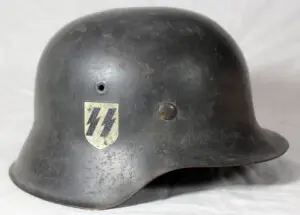 By in large, the most common paint scheme seen on German helmets during the war was rough textured field gray. For anyone who wants the so-called standard German helmet, textured field gray is what I recommend.
By in large, the most common paint scheme seen on German helmets during the war was rough textured field gray. For anyone who wants the so-called standard German helmet, textured field gray is what I recommend.
The German military did try to standardize helmet paint color during the war; however, the color guidelines were never fully implemented. There were several reasons for this. Many of the companies who held contract to provide paint, were unable to fulfill their contract due to high demand and thus outsourced to other paint vendors. To complicate matters further, military supply depots often re-painted helmets with whatever gray-green paint was available. Anyone who has handled a large number of original helmets can a test to the shades of field gray varies greatly. I personally have seen the original helmet ranging from slate gray to olive to almost khaki.
I currently offer three different shades of field gray. They vary from light to extremely dark. If you do want something more unusual, let me know what it is, and I will see what I can do.
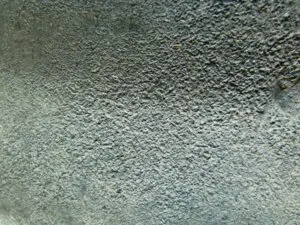
Close up of an aluminum oxide textured finish on an original German helmet
I use real aluminum oxide powder or saw dust on request.
Starting in late 1939 the helmet factories started to mix aluminum oxide powder into their paint. This act greatly reduced the glare on the helmets. Later in the war, many factories started to use saw dust instead when aluminum oxide became scare. Original helmets tend to range from very light texturing to extremely heavily. From the original helmet I have personally examined, it seems that some factories tended to have rougher textured finishes than others. Helmets from Sachsische Emaillerwerk seem to almost always feature an extremely rough factory finish
 I will not answer any questions about my methods. I have experimented for many years to come up with these techniques. I have used a lot of trial and error. I re-painted my one of my M35s so many times my wife said she thought it would disintegrate from being stripped too many times. I will say one thing that makes me different then some of my competitors. I use natural means. I do not use paint or dyes to create the illusion of age. My methods are natural, I do have a few tricks to speed the process up, but I think you will agree the end result is must more convincing.
I will not answer any questions about my methods. I have experimented for many years to come up with these techniques. I have used a lot of trial and error. I re-painted my one of my M35s so many times my wife said she thought it would disintegrate from being stripped too many times. I will say one thing that makes me different then some of my competitors. I use natural means. I do not use paint or dyes to create the illusion of age. My methods are natural, I do have a few tricks to speed the process up, but I think you will agree the end result is must more convincing.
I only use industrial oil based paint. The paint I use is the closest available to the German wartime manufactured paint. Some of it I mix myself, and some of it I have mixed for me The paint is very durable and will hold up well during a reenactment, however if you drop your helmet or have it dinged somehow, the paint will probably chip.
Unfortunately, I can not sell my paint. The law requires a hazmat license, which I do not have.
I offer the SS Poucher, EF and Q patterns decals. These decals were designed in the 1930s and were used for the entire war. Not all factories produced SS helmets. As of right now it is believed that only Eisenhuttenwerke, Quist and Emaillierwerke A.G. Fulda produced helmets for the SS. That said helmets from other factories did find their way into SS inventories and these would have been re-decaled with so called re-issue Poucher SS decals.

EF pattern SS decal
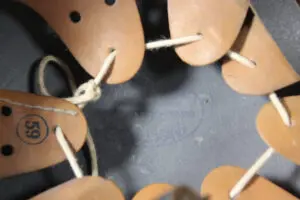
One of our accurate inspector's ink stamps for an EF marked M42
Dome stamps were rubber ink stamps that were stamped into the dome of the helmet by inspectors. They were stamped with either black or purple ink. It is believed that only about 25% of helmets received this mark. Helmets made before 1939 were stamped with the year of production. In the later part of 1939, the stamps were no longer dated and instead were specific to whatever factory made the helmet. In recent years, many online vendors have begun to sell plastic decals to replicate these stamps. This is completely erroneous; no decals were ever used.
I currently offer correct ink stamps that are dated 1937, 1938 and 1939. I also offer the post 1939 specific factory stamp to, Eisenhuttenwerk, Quist, Vereinigte Deutsche Nickelwerke and Emaillerwerk. Helmet made at Sachsische Emaillerwerk rarely were stamped by inspectors, but I do offer the correct stamp for this factory.

Original M24 Liner
I am proud to say I am currently the only vendor out there that offers this rare liner and chinstrap for sale. In the 1920s the Reichswehr started the long process of refitting all the old M16, M18 and M18 cutout with new liners. The liner was more or less an improvement on the M16 liner. The new liner retained the three pad system found on the M16 version, but had steel D-rings riveted to the leather band to attach the new, improved chinstrap. In fact, it is probable that many of the existing M16 liners may have been modified to fit the new 1924 specifications.
The new strap featured an adjustable black roller buckle. Instead of being riveted to the liner like the 1918 version, one side clipped to the liner D-ring while the other side looped through a leather keeper. Thus allowing the chinstrap to be transferred to another liner when necessary
The M1924/27 liner and chinstrap continued to be worn even after the M1931 liner was produced and well into the war. Many transitional helmets feature these models. I have even seen an M40 helmet with a M1927 chinstrap.
M24/27 Liner with M27 chinstrap
Zimmerit is a plaster like anti-magnetic paste. It was applied to vehicles to deflect magnetic ordinance. Some soldiers applied this paste to their helmets and painted over it, giving the helmet a rough and lumpy texture. In many cases, however, on original helmets what appear to be Zimmerit is actually a sand, grit or ash composition mixed directly into the paint and slathered over the helmet shell. The desired effect here was to mimic the landscape and reduce glare on the helmet. I do offer both Zimmerit or grit finish on request.
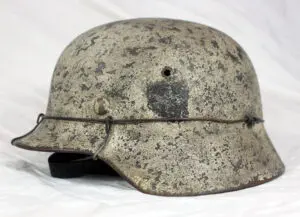
M35 With Snow camo
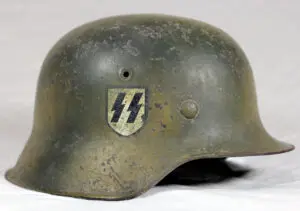
M42 with a two-color tropical camo scheme
I offer all the standard camo colors found on original helmet, red-brown, brown, dark green, grass green, tan, mustard, white exedra. Camouflage can be applied both by hand, or it can be sprayed. These are plenty of photographic that it was done both ways. Generally, troops who fought with armored units sprayed their helmet opposed to hand painted them due to the fact that spray guns were issued to all armored units.
As a point of interest, camouflage paint was issued to troops in small tins similar to shoe polish. The dry contents could be thinned with almost anything, from mineral spirits, gasoline to water. Paint was also obtained locally. Original camouflage helmet vary in appearance and color, ranging from matted finishes to semi-gloss.
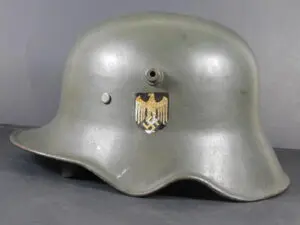
M18 cut out helmet with pre-war apple green finish

Original M35 with a darker shade of pre-war apple green or pea green finish
M35 and transitional helmet were painted a pale gray green color that is generally referred to as apple green. Original helmets painted this color vary greatly in color and texture. These helmets range from darker gray-green, mint green to almost a sea foam green. These helmets were usually over-sprayed with a semi-gloss lacquer top coat. The smooth semi-gloss finish looked great on the parade field, but the glare from the smooth helmet shell made a perfect target for snipers in the Polish and French Campaigns. As early as 1939, supply depots were already re-painting helmets with more matted paint. Some of these early so-called supply depot re-paints feature an extremely diverse color scheme. This is probably the result of supply using whatever paint was on hand.
These are two original M35 helmets; note the difference in the shade of apple green.

M18 Hungarian Berndorfer with clay brown finish

Original sample of WWI German field gray paint next to A&SR paint
The field gray paint used on German M16 and M18 helmets during the World War I period differs greatly from the apple green of WWII and the field gray of the 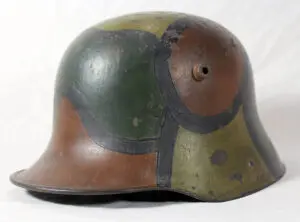 Weimar era. The Field gray I offered was a match to an original M16 helmet shell. I also offer Austrian brown-gray should you have an Austro-Hungarian helmet that needs to be re-painted. A&SR also all the various colored used in WWI by most of the participant.
Weimar era. The Field gray I offered was a match to an original M16 helmet shell. I also offer Austrian brown-gray should you have an Austro-Hungarian helmet that needs to be re-painted. A&SR also all the various colored used in WWI by most of the participant.
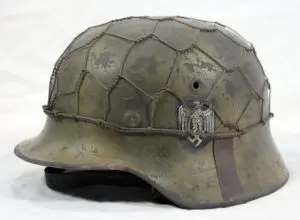 Yes, I offer heavy gauge European single twist zinc plated iron farm wire. I have 3, 5, or 6 twists. I will also age it to your specifications. Generally, zinc-plated wire dulls with age, but does not rust too much. Most wire of the 1930s and 1940s was, in fact, zinc plated. If you examine original chicken wire baskets, many are not too rusty. The wire I offer is woven by hand by yours truly and, as far as I can tell, is some of the best on the market.
Yes, I offer heavy gauge European single twist zinc plated iron farm wire. I have 3, 5, or 6 twists. I will also age it to your specifications. Generally, zinc-plated wire dulls with age, but does not rust too much. Most wire of the 1930s and 1940s was, in fact, zinc plated. If you examine original chicken wire baskets, many are not too rusty. The wire I offer is woven by hand by yours truly and, as far as I can tell, is some of the best on the market.
Farm wire over a Zimmerit-painted helmet
This is truly a growing list, but to name a few: WWI Imperial Russian, WWI and WWII Italian, WWI and WWII British, WWI and WWII French,, Danish, Romanian, Polish, and Japanese. 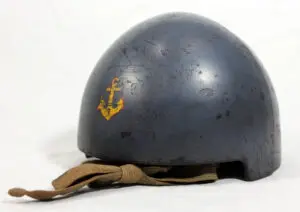 and WWI and WWII American helmets. Contact me if you have questions.
and WWI and WWII American helmets. Contact me if you have questions.
